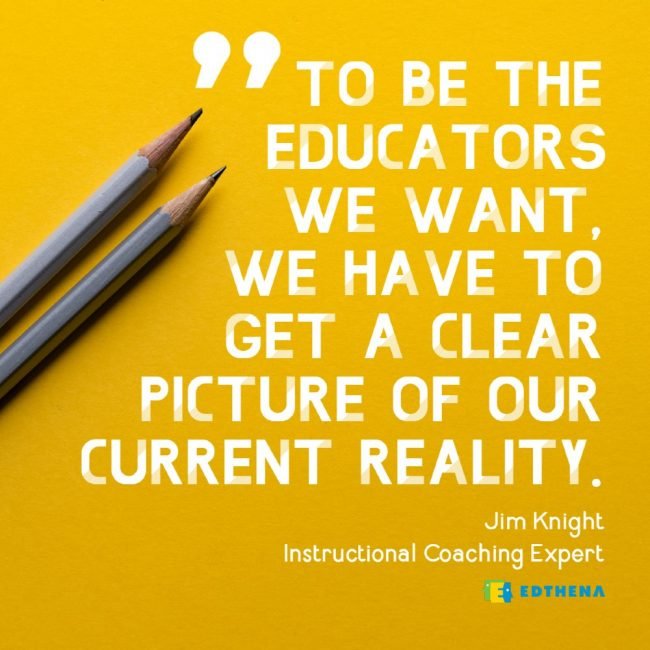Jim Knight Says Video Observation Paints a Clear Picture of Your Current Reality and Inspires Change
- Instructional coaching guru Jim Knight lays out reasons for why video should be a pivotal part of professional learning for teachers regardless of if they are teaching in the classroom or teaching virtually.
- Educators have defense mechanisms that prevent them from seeing a clear picture of what is happening in their own classroom.
- Jim stresses that video gives educators a clear vision of their reality, helping to recognize errors that may not have been seen before
Teaching is hard work that needs constant refinement. If not, then educators wouldn’t prioritize continuous professional learning. But it turns out that continuous learning is hard work, too. It requires a constant ability for teachers to accurately define what needs to be changed in their classrooms.
According to Jim Knight, instructional coaching author, and researcher, getting a clear picture of current reality can be eased by one simple thing: videos of classroom teaching. “When you use video in coaching, it’s a dramatically different experience,” said Jim during his recent conversation Edthena CEO, Adam Gellar.
Jim sat down with Adam for a Lounge Talk conversation for the professional development blog PLTogether.
Jim Knight has spent more than two decades studying instructional coaching, effective learning, and professional learning. He has shared his knowledge by authoring multiple books including Focus on Teaching: Using Video for High-Impact Instruction and Better Conversations: Coaching Ourselves to Be More Credible, Caring, and Connected. Jim is an expert in fostering reflection among teachers alongside their coaches to maximize learning opportunities in the classroom.
In his conversation with Adam, Jim Knight reflected on how video has positively impacted educators. He believes that only after educators see the real version of their classrooms can they “see the need for change.” Even a bad video can be a motivating factor for an educator because it allows them to see what they need to improve on.
“People are motivated when they see reality because they either want more of this or less of that,” said Jim Knight.
You can watch part 2 of the 4-part interview segment above, and we have shared some of the key highlights below.
Why should video be part of professional learning and instructional coaching?
Video gives people a clear vision of their reality. Performers review videos of their strategy to improve, and with teaching, we can use the same concept.
There are several reasons why we don’t have a clear vision of what we do while performing. Perceptual errors and defense mechanisms often keep us from seeing reality the way that it is.
Accepting our mistakes every day could affect who we are, so instead, we do things like blame other people or minimize the problem. So combining all of those reasons, what we think is happening and what is really happening is quite different. Because we don’t see a clear picture of reality, we don’t see the need for change. We minimize the problem or explain things away.
People are more motivated when they see reality. What’s more, it ensures that they focus on the right areas. When you use video in instructional coaching, it’s a dramatically different experience. You’re helping the person hit their goal as opposed to trying to force them to meet one.
Video now seems like a “must-have” versus a “nice-to-have.” Why is the value of video increasing for teacher professional development?
Well, if I’m not the person I think I am, then I need to learn. Learning really is about changing that story. You don’t change your story by hiding from reality. You change it by cautiously entering into reality so you can get better.
When it comes to using video, I think I respect the discretion of a teacher to choose what they’re ready for, and what they want to do.
But I do believe to really get good at what you do, you have to see it. It’s a critical thing.
Video is becoming increasingly more valuable for reflection. Why wouldn’t someone introduce it into the coaching relationship?
Reasons that some individuals may be resistant to using video may be due to those defense mechanisms. Life is tough and if you have to carry around negativity, it can be difficult. So to protect ourselves, we implement defense mechanisms. The issue is to be the educator that we want to be, we have to get a clear picture of our current reality.
The video is going to show us a side of us that we haven’t seen and it’s going to be hard. It can change the story of who you are. The thing is, ultimately, you learn from video. Learning is about changing that story, to feel efficacious. You don’t get it by hiding from reality, you get it by cautiously entering into reality so you can improve.

I think there are times when you don’t want to face your evaluations, you aren’t up for it. However, to become a master of what you do, you have to put in the effort. Every teacher should be watching themselves if they choose to. Video is a powerful tool for learning.
Like what you’re reading? Watch more videos at PLtogether.org or read our related lounge interview with Bob Lenz about how to incorporate project-based learning during the time of distance teaching.
Interested to hear more from Jim Knight? Check out this past interview with Jim Knight exploring trust within the coaching relationship.


